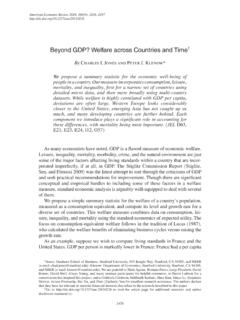Transcription of The Allocation of Talent and U.S. Economic Growth
1 The Allocation of Talentand Economic GrowthChang-Tai HsiehChicago Booth and NBERErik HurstChicago Booth and NBERC harles I. JonesStanford GSB and NBERP eter J. Klenow Stanford University and NBERA pril 6, 2018 Version 1960, 94 percent of doctors and lawyers were white men. By 2010, the fractionwas just 62 percent. Similar changes in other highly-skilled occupations have oc-curred throughout the economy during the last fifty years. Given the innatetalent for these professions has unlikely changed differentially over time acrossgroups, the change in the occupational distribution since 1960 suggests that a sub-stantial pool of innately talented blacks and women in 1960 were not pursuing theircomparative advantage.
2 We examine the effect on aggregate productivity of theremarkable convergence in the occupational distribution between 1960 and 2010through the prism of a Roy model. About one-quarter of Growth in aggregate outputper person over this period can be explained by the improved Allocation of Talent . We are grateful to Daron Acemoglu, Raquel Fernandez, Kevin Murphy, Rob Shimer, Ivan Werning,three anonymous referees, and numerous seminar participants for helpful comments. Jihee Kim, Mun-seob Lee, Huiyu Li, Ziho Park, Cian Ruane, and Gabriel Ulyssea provided excellent research and Hurst acknowledge support from the University of Chicago s Booth School of Business, andKlenow from the Stanford Institute for Economic Policy Research (SIEPR).
3 THE Allocation OF the last 50 years, there has been a remarkable convergence in the occupationaldistribution between white men, women, and blacks. For example, 94 percent of doc-tors and lawyers in 1960 were white men. By 2010, the fraction was just over 60 per-cent. Similar changes occurred throughout the economy during the last fifty years,particularly among highly-skilled occupations. A large literature attempts to explainthese no formal study has assessed the effect of these changes on aggre-gate productivity.
4 Since the innate Talent for a profession among members of group isunlikely to change over time, the change in the occupational distribution since 1960suggests that a substantial pool of innately talented blacks and women in 1960 werenot pursuing their comparative advantage. The resulting (mis) Allocation of Talent couldpotentially have important aggregate paper measures the aggregate productivity effects of the changing allocationof Talent from 1960 to 2010. To do so, we examine the differences in labor marketoutcomes between race and gender groups through the prism of a Roy (1951) modelof occupational choice.
5 Within the model, every person is born with a range of talentsacross all possible occupations. In an efficient Allocation , each individual chooses theoccupation where she obtains the highest return for her introduce three forces that will cause individuals to choose occupations wherethey do not have a comparative advantage. First, we allow for discrimination in thelabor market. Consider the world that Supreme Court Justice Sandra Day O Connorfaced when she graduated from Stanford Law School in 1952. Despite being rankedthird in her class, the only private sector job she could get after graduating was as a legalsecretary (Biskupic, 2006).
6 We model labor market discrimination as an occupation-specific wedge between wages and marginal products. This tax is a proxy for manycommon formulations of taste-based and statistical discrimination found in the , the misallocation of Talent can also be due to barriers to human capital in-1 See, for example, Blau (1998), Blau, Brummund and Liu (2013b), Goldin (1990), Goldin and Katz(2012), Smith and Welch (1989) and Pan (2015). Detailed surveys of this literature can be found in Altonjiand Blank (1999), Bertrand (2011), and Blau, Ferber and Winkler (2013a).
7 2 See, for example, Becker (1957a), Phelps (1972) and Arrow (1973). A summary of such theories can befound in Altonji and Blank (1999).2 HSIEH, HURST, JONES, AND KLENOW vestment. We model these barriers as increased monetary costs associated with accu-mulating occupation-specific human capital. These costs are a proxy for many differ-ent race- and gender-specific factors. Examples include parental and teacher discrim-ination in favor of boys in the development of certain skills, historical restrictions onthe admission of women to colleges or training programs, differences in school qualitybetween black and white neighborhoods, differences in parental wealth and schoolinglevels across groups which alter the cost of investing in their children s human , we allow for differences in preferences or social norms to drive occupa-tional choice differences across groups.
8 For example, there might have been strongsocial norms against women and blacks in high skilled occupations in the 1960s. Thepotential for preference or social norm differences across groups has been highlightedin the work of, among others, Johnson and Stafford (1998), Altonji and Blank (1999),and Bertrand (2011). We treat the home sector as additional occupation. As a result,we also allow for differences across groups in the extent to which they want to workin the home sector. This factor can capture changes in social norms related to womenworking at home.
9 However, without the loss of generality, we can interpret the changein the preference for the home sector over time broadly so that it also includes changesin the preference for children or the ability to control the timing of measure these three forces from the data, we make a key assumption that thedistribution of innate Talent of blacks and women relative to white men is constantover time. With this assumption, we back out thechangein labor market frictions,3 Here is an incomplete list of the enormous literature on these forces.
10 Karabel (2005) documentshow Harvard, Princeton, and Yale systematically discriminated against blacks, women, and Jews inadmissions until the late and Krueger (1992) document that public schools for blacksin the South in the 1950s were underfunded relative to schools for white Chay,Guryan and Mazumder (2009) for evidence on the importance of improved access to health care forblacks. Goldin and Katz (2002), Bailey (2006), and Bailey, Hershbein and Milleri (2012) document thatinnovations related to contraception had important consequences for female labor market outcomesand educational attainment.









